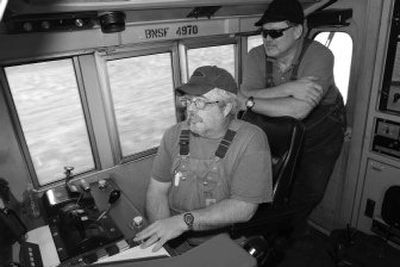An aging industry looks down the line

BILLINGS – Steve Miller is 52 and beginning to think about the end of the line.
A career railroader, the Montana Rail Link engineer has put in enough years to retire. But he can’t draw his pension until he hits 60, the magic age at which he will qualify for full retirement and benefits.
“Those eight years are going to go fast,” he said. “I have mixed emotions about it.”
Employees like Miller represent the aging demographic at MRL. They also represent a challenge for the entire industry.
Tom Walsh, president of MRL, points out that the average age of MRL employees is fast approaching 45. Considering the industry’s alluring retirement policy – full retirement at age 60 for employees with 30 years of service – and expectations of significant growth during the next 20 years, he would like to avert the potential train wreck ahead. The company’s single largest challenge, he said, is recruiting, developing and retaining the best people.
“We always want to hire the best and the brightest,” he said. “It’s just more work to get them.”
This fall, MRL will celebrate its 20th anniversary. Two decades ago, the fledgling company had two weeks to fill its entire roster of 600 people. It did so, but those were different times. Rail mergers were common, and the resulting layoffs created a pool of railroaders looking for work.
“In the late ‘80s, you had 20 to 30 people (apply) for a job,” Walsh said. “You could choose from whoever you wanted. Now, you have two to three to choose from.”
Walsh doesn’t expect the situation to change soon. And that presents a critical challenge as the industry faces a surge in business. By 2020, he says, the rail industry projects a 70 percent increase in the tons of goods moved nationwide. He attributes the boom to a shift from truck to rail transport. Some of the pressure will be absorbed through increased employee efficiency and a shift to heavier and longer trains, he says. But ultimately, he foresees a need for 20 percent more employees.
MRL is not alone in its quest to replenish its ranks. Across Montana, the rail industry is competing for a limited pool of employees in a state with an unemployment rate of 2 percent, the lowest in the nation.
Gus Melonas, spokesman for BNSF Railway, said 38 percent of the company’s employees are 50 or older and only 24 percent are younger than 35.
“BNSF is in the hiring mode and will add positions across Montana this year,” he said. “For decades, BNSF was one of the top two employers in the state, and it remains in the top five.”
In fact, earlier this year the company announced that it planned to add 106 employees to its Montana payroll. They will fill a variety of positions, including track, signal, mechanical and conductor trainees. The extra positions will also beef up crews installing new rail ties between Billings and Huntley and Laurel and Wyoming, part of BNSF’s $54.4 million statewide capital improvement plan for this year.
Steve Sheldon, marketing manager for the Yellowstone Valley Railroad, a short line with headquarters in Sidney, says he’s looking for qualified employees, too. His competition, however, comes from the oil field, not an aging work force.
“More than attrition, it would be lack of an applicant pool,” he said.
Across the nation, rail companies have stepped up recruiting efforts to fill in behind retiring baby boomers.
The Association of American Railroads reports that the nation’s largest rail companies expect to fill 80,000 rail-related jobs that will be created over the next six years. Citing the rail industry as “one of the few that doesn’t outsource jobs or facilities overseas,” the association says many companies target Iraq war veterans to fill that demand. In fact, last year, for the second consecutive year, the Union Pacific Railroad was judged the country’s most military-friendly employer. The vets are considered good fits for rail jobs because they pay attention to detail, they’re extremely safety conscious, they’re used to working in a variety of weather conditions, and they offer leadership skills that transfer well into the industry.
According to Walsh and Melonas, many Montana farm and ranch kids are also well-suited to the profession, for many of the same reasons.
“Montanans have historically been great railroaders,” Melonas said.
Good pay, tough schedule
The ad reads $19.70 per hour, starting pay for new hires. But the listing for the switchman trainee position also stipulates that the applicants must be available for work 24 hours a day, seven days a week. Weekend and holiday shifts are required.
“Trains show up on our door at all sorts of times,” Walsh said. “When your name gets called up, you go – 10 a.m. or 2 a.m. Regular hours? They don’t exist.”
Traditionally, railroad blood has flowed from father to son and often to grandson. That’s the case for Miller, whose grandfather was an engineer on the Santa Fe and whose father clerked for the Santa Fe, both in Kansas. He hired on when a previous wave of employees – World War II vets – were aging out.
Like many of his generation, Miller stayed on with the railroad. When industry layoffs cut his position in Kansas, he moved to Montana and hired on with MRL.
Walsh believes that tradition of lifelong commitment is slipping away.
“You hire a new person at 18, but they don’t think this way,” he said, noting that the company invests tens of thousands in training a new hire. “How do we keep them interested and motivated to want to stay with us a long time? That’s something we never had to deal with in the past.”